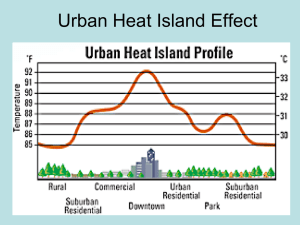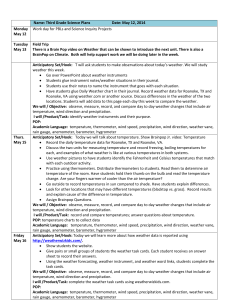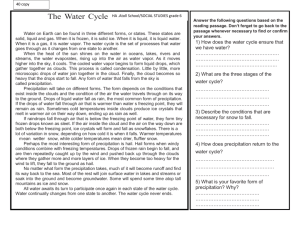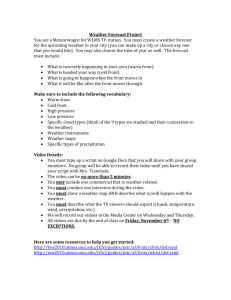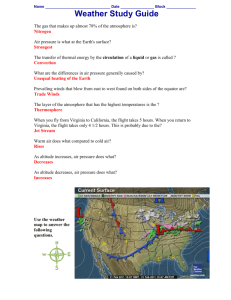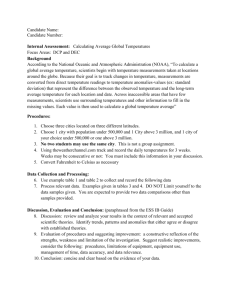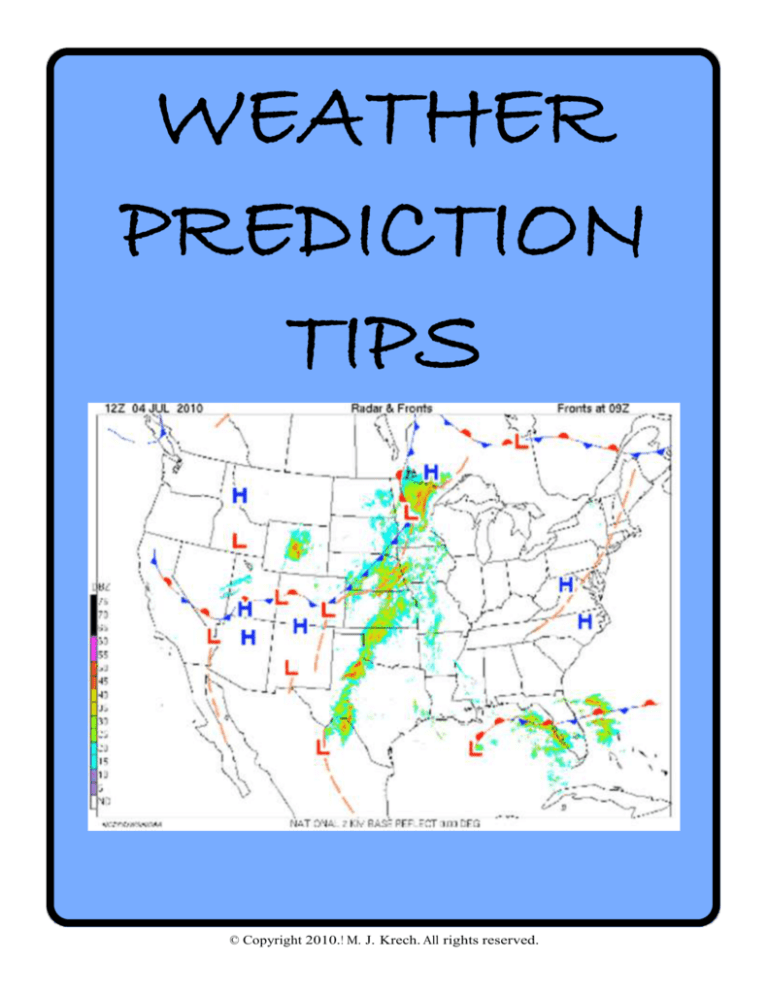
WEATHER
PREDICTION
TIPS
© Copyright 2010.! M. J. Krech. All rights reserved.
1. CYCLONES bring clouds and precipitation
L
Forecast Tip:
A cyclone is an area of low pressure around which the winds flow counterclockwise in the
northern hemisphere. Air converges into a low pressure center which causes air to rise. The
rising motion may produce clouds and precipitation.
Different precipitation types include rain and thunderstorms in summer and fall, to rain,
thunderstorms, and even snow during the winter. A low is represented on a weather map by
a red "L". As a cyclone approaches, the likelihood of clouds and precipitation increases.
Forecast Tip:
Winds flow counterclockwise around a low pressure center in the northern hemisphere.
Southerly winds associated with an approaching cyclone are likely to result in warmer
temperatures while northerly winds found on the backside of a low, or once a low has passed
through, typically result in a cooling trend.
2. ANTICYCLONES bring fairer weather
H
Forecast Tip:
With air moving away from a high pressure region, air must sink from above to replace it.
This sinking motion leads to generally fair skies and no precipitation near the high.
Forecast Tip:
Winds flow clockwise around a high. Northerly winds associated with an approaching high
are likely to result in colder temperatures while southerly winds found on the backside of a
high, or once a high has passed through, typically result in a warming trend.
© Copyright 2010.! M. J. Krech. All rights reserved.
3.
COLD FRONTS colder temperatures and possibly precipitation
Forecast Tip:
The air mass behind a cold front is likely to be cooler and drier than the one before the front.
If a cold front is approaching, precipitation is possible just before and while the front passes.
Behind the front, expect clearing skies, cooler temperatures, and lower relative humidities.
Upward motions along a cold front are typically more vigorous, producing deeper clouds and
more intense bands of showers and thunderstorms. However, these bands are often quite
narrow (a couple hundred kilometers across) and move rapidly just ahead of the cold front.
4.
WARM FRONTS warm and more moist conditions
Forecast Tip:
The air mass behind a warm front is likely to be warmer and more moist than the one before
the front. If a warm front is approaching, light rain or light winter precipitation is possible
before and as the front passes. Behind the front, expect clearing skies, warmer temperatures
and higher relative humidities. Light intensity precipitation develops ahead of a warm front.
© Copyright 2010.! M. J. Krech. All rights reserved.
5.
STATIONARY FRONTS runway for cyclones
Forecast Tip:
If a stationary front is nearby and a low pressure center is approaching along the front,
heavy amounts of precipitation are possible. There is usually a noticeable change in
temperature and wind shift crossing from one side of a stationary front to the other. Low
pressure centers sometimes migrate along stationary fronts, dumping heavy amounts of
precipitation in their path. Such a scenario has been depicted above.
6.
OCCLUDED FRONTS when a cold front catches a warm front
Forecast Tip:
Ahead of an occluded front, temperatures can be warmer while temperatures behind the
front they can be cooler. The air mass behind the front is also drier as shown by the lower
dew points. Wind direction reports to the east of the front are from the east or southeast,
while winds behind the front are from the west or southwest. Convergence of the easterly
winds ahead of the occluded front and the westerly winds behind it can result in showers of
rain or snow. With the passage of an occluded front, weather conditions will likely turn from
cool to cold. Winds will swing around from easterly to westerly or southwesterly with rain
or snow showers possible, (depending on how cold the temperatures are).
© Copyright 2010.! M. J. Krech. All rights reserved.
EFFECTS OF CLOUD COVER ON FORECASTED TEMPERATURES
7. CLOUDS IN THE DAYTIME:
Forecast Tip:
When forecasting daytime
temperatures, if cloudy skies
are expected, forecast lower
temperatures than you would
predict if clear skies were
expected.
Forecast Tip:
During the day, the earth is heated by the sun. If skies are clear, more heat reaches the
earth's surface (as in the diagram below). This leads to warmer temperatures.
However, if skies are cloudy, some of the sun's rays are reflected off the cloud droplets back
into space. Therefore, less of the sun's energy is able to reach the earth's surface, which
causes the earth to heat up more slowly. This leads to cooler temperatures.
8. CLOUDS IN THE NIGHTTIME:
Forecast Tip:
When forecasting nighttime
temperatures, if cloudy skies
are expected, forecast warmer
temperatures than you would
predict if clear skies were
expected.
At night cloud cover has the opposite effect. If skies are clear, heat emitted from the earth's
surface freely escapes into space, resulting in colder temperatures.
However, if clouds are present, some of the heat emitted from the earth's surface is trapped
by the clouds and re-emitted back towards the earth. As a result, temperatures decrease more
slowly than if the skies were clear.
© Copyright 2010.! M. J. Krech. All rights reserved.
HIGH AND LOW PRESSURE CENTERS ON FORECASTED TEMPERATURES:
9. HIGH PRESSURE CENTER:
H
Forecast Tip:
If a city is expected to be located west of a high pressure center then warmer temperatures
are likely. However, if the city is expected to be in the northerly winds of a high pressure
center, then forecast colder temperatures. Cities under the influence of high pressure centers
can expect generally fair weather with little or no precipitation.
10. LOW PRESSURE CENTER:
L
Forecast Tip:
If a city is expected to be located west of a low pressure center then colder temperatures are
likely. However, if the city is expected to be in the southerly winds of a high pressure center,
then forecast warmer temperatures. Cities under the influence of low pressure centers can
expect generally cloudy conditions with precipitation.
© Copyright 2010.! M. J. Krech. All rights reserved.
Weather Prediction #1
Name
Class
1. How many Highs do you see on this map?
Color Blue.
What type of weather is associated with a High Pressure area?
2. How many Lows do you see on this map?
Color Red.
What type of weather is associated with a Low Pressure area?
© Copyright 2010! M. J. Krech. All rights reserved.
3. How many Cold Fronts do you see on this map?
Color Blue.
What type of weather is associated with a Cold Front?
4. How many Warm Fronts do you see on this map?
Color Red.
What type of weather is associated with a Warm Front?
5. Predict the weather for Jefferson City, Missouri one day from now:
6. How do you know? What is the evidence for your prediction?
7. Predict the weather for Detroit, Michigan one day from now:
8. How do you know? What is the evidence for your prediction?
9. Predict the weather for Seattle, Washington one day from now:
10. How do you know? What is the evidence for your prediction?
© Copyright 2010! M. J. Krech. All rights reserved.
Weather Prediction 2
Name
Class
1. How many Cold Fronts do you see on this map?
Color Blue.
What type of weather is associated with a Cold Front?
2. How many Warm Fronts do you see on this map?
What type of weather is associated with a Warm Front?
© Copyright 2010.! M. J. Krech. All rights reserved.
Color Red.
3. How many Highs do you see on this map?
Color Blue.
What type of weather is associated with a High Pressure area?
4. How many Lows do you see on this map?
Color Red.
What type of weather is associated with a Low Pressure area?
5. Predict the weather for Miami, Florida one day from now:
6. How do you know? What is the evidence for your prediction?
7. Predict the weather for Pittsburgh, Pennsylvania one day from now:
8. How do you know? What is the evidence for your prediction?
9. Predict the weather for Washington, D.C. one day from now:
10. How do you know? What is the evidence for your prediction?
© Copyright 2010.! M. J. Krech. All rights reserved.
© Copyright 2010.! M. J. Krech. All rights reserved.



